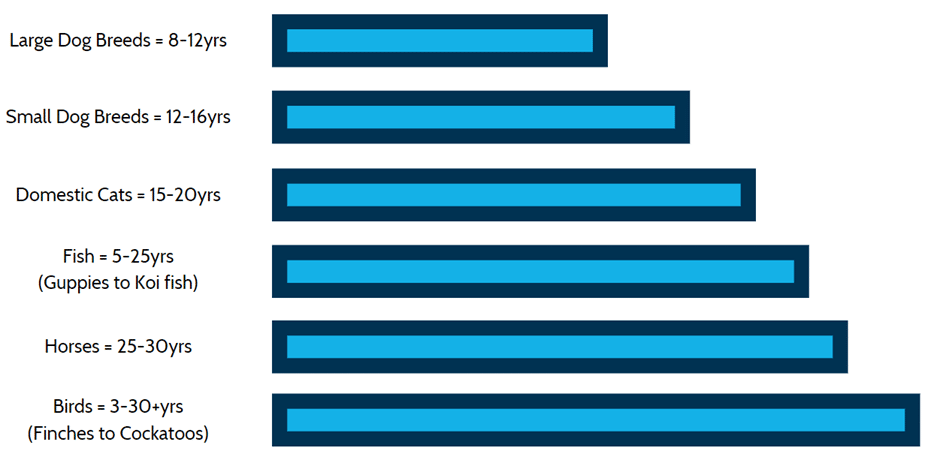For many of us, our pets are beloved members of our families. They bring companionship and happiness, and like our human family members, they come with their own needs that require financial consideration. According to the 2021-2022 National Pet Owners Survey by the American Pet Product Association, the majority of American households (about 70%) have pets today.[i] Though in the past it may not have been the norm to provide for our animals in our estate planning, times have changed. Pet trusts and other options are available to owners to provide for their animals when they no longer can – and it’s not just for the wealthy anymore. A survey of 903 pet owners by Securian Financial Group indicated that 44% of pet owners have made either written or verbal plans for the care of their pets.[ii] Increasingly, pet owners are turning to financial advisors for advice, and as owners ourselves, we’ve shared many of our own personal tips that we’ve taken to care for our furry (and feathered) family members. Here are six steps for pet owners to consider in their estate plan.
Step 1: Calculate the standard of care and annual cost of your pet.
Before you can accurately determine how to provide for your pet, you need to calculate what he or she costs your household each year. The National Pet Owners Survey of 2021-2022 also tells us that pet spending is on the rise, with food being the top expense. Keeping in mind that the average life expectancy for your animal will vary based on breed, health, and diet (among other factors), ask yourself:
- Which animals am I covering? Many owners have multiple pets with varying needs and expenses.
- How much does it cost for basics of food, pet insurance, vet care, medications, and supplements?
- Will my animal require the same care throughout his or her lifetime?
- As my pet ages, what potential health issues should I make provisions for?
- What flexibility am I willing to offer as far as providers (including veterinarians, dog walkers, groomers, etc.)?
Once you’ve answered these questions, it’s important to list in detail how your animal should be cared for. This includes naming preferred veterinarians, groomers, pet walkers, and even doggie daycares. What type of food does he or she like best? Where should he or she sleep? How often should your animal be groomed? Have new toys? Get treats? What type of interaction should your pet have with other animals? All of these things may be second nature to you, but leaving instructions is helpful when calculating the annual expense of your pet. Also, it’s important to factor in the life expectancy of your pet when determining costs. See below for a range in life spans of common house pets.[iii]

Step 2: Determine the appropriate trustee and caretaker.
If you’ve ever heard of someone leaving their entire estate to their pets, it’s impossible. Pets are considered a type of property and legally cannot own property on their own. So, if you leave an inheritance to them or name them as beneficiaries, state laws and your estate plan will likely determine who actually inherits the assets. To ensure your pet is provided for, people often designate two people to manage their estate – a caregiver and a trustee. The trustee is in charge of the finances to manage pet care and will have the legal responsibility to ensure that the money is properly used by the caretaker to care for your client’s pet. The caretaker is a custodial parent, and your pet will live with them. While some states allow for one person to fill both roles, having both a trustee and a caregiver is a good idea, as it allows for checks and balances in case an issue arises with either person. Compensation for these roles comes up often, so factor this into your cost calculation.
Step 3: Put it in writing.
Now that you’ve calculated your pet’s costs and determined who will provide care and manage your finances, it’s time to get the details in writing. Work with your estate planning attorney and your advisor to determine the best approach for you. Options include:
Including language in your will:
If you know your caregiver well and trust them to follow your wishes, a provision in your will may work well enough for you. Your will disposes of your property (including your pets) and leaves them to a beneficiary (who in this scenario is your caregiver). Just know that leaving an animal to a beneficiary isn’t a guarantee that they will follow your guidance or use the funds given to them to cover your pet’s costs.
Drafting a Pet Trust:
Increasingly, pet owners are opting to create a pet trust. Approved in 2000 under Section 408 of the Uniform Trust Code, a pet trust is an effective tool to plan for the care of your animals. As with other types of trusts, a pet trust is like a company that exists only to pay for the needs of your pet as you determine. All 50 states in the U.S. have adopted some form of pet trust.
Creating informal agreements:
It is still common for owners to make an informal agreement with a trusted friend or family member to care for their pet when they no longer can. That said, informal agreements offer the least amount of protection. If, for instance, you gave your pet to someone when you pass away, you have no control over how that person will care for or provide for your pet.
Other options:
With Powers of Attorney and Letters of Instruction through your power of attorney, you can give your agent the ability to care for your pets and use your money to pay for this care. As with an informal agreement, there’s little to no way to guarantee that the person who inherits your pet provides the kind of care you want it to receive. Letters of instruction are designed to allow you to leave behind instructions, information, or express wishes that have little effect on your property or assets. However, since letters of instruction are not enforceable, and they can’t be used to set aside assets for pet care, they’re best used in conjunction with other estate planning tools.
Step 4: Make sure your financial documentation is up to date.
Life changes. Relationships change. Once you have an estate plan in place and a provision or pet trust for your animals, you’ll want to review these documents regularly for any changes you may wish to make – to costs, to caregivers or trustees, or even to providers who might retire or relocate.
Step 5: Provide funds for your pet’s care.
If you’ve decided to set up a pet trust, funding is the process of transferring assets into the trust’s name so the trustee can distribute them to the caregiver. Once your trust is created, you can transfer assets to it just as you would to an individual. You can, for example, go to a bank, set up a new account in the trust’s name, write a check to the trust, and deposit the funds in the trust’s account. Because your pet trust is designed to care for your pet in the event of your death, you may not want to fund it immediately, as those funds will be tied up in the trust and won’t be available to you for other purposes. It’s common for people to direct, for example, that their pet trust is funded only after they die. If you want to create a pet trust to care for your pet in the event you become disabled, you can create the trust and fund it immediately.
Step 6: Provide direction for any remaining funds.
Beyond naming and identifying beneficiaries, you must also choose how you want the trust’s funds distributed after your pet dies by choosing a remainder beneficiary. Remainder beneficiaries can be an individual, such as a relative, or a group or organization, such as a church or charity. In general, it’s best not to leave the leftover funds to a caregiver or trustee, as this might give them an incentive to artificially shorten the animal’s life or provide less-than-adequate care.
Estate planning for your pets can be easily overlooked when putting together a roadmap of your wishes. Having a plan in place offers you peace of mind knowing that you’ve taken great care and considered the needs of your beloved pets, ensuring that even in your absence, they’ll be cared for and protected during their lifetimes.




